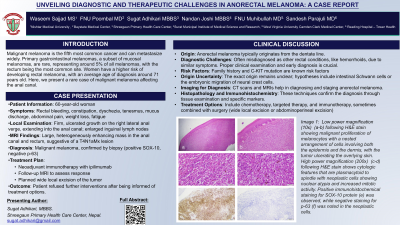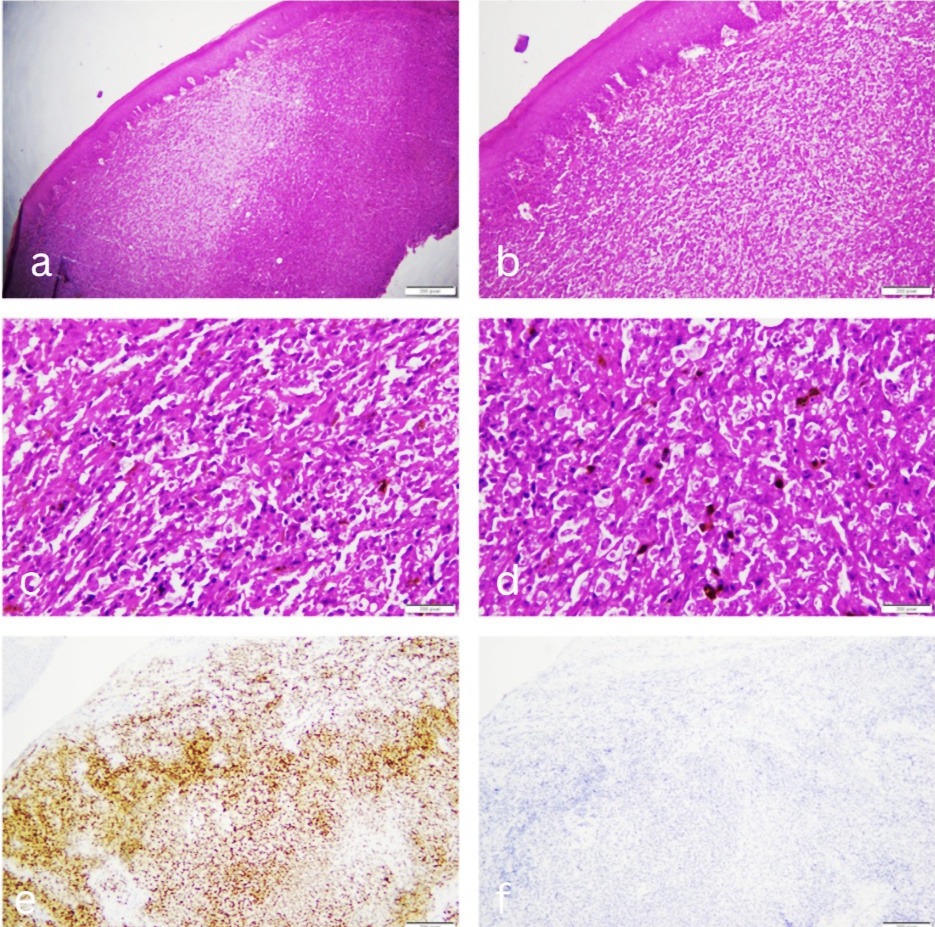Sunday Poster Session
Category: Colon
P0260 - Unveiling Diagnostic and Therapeutic Challenges in Anorectal Melanoma: A Case Report
Sunday, October 27, 2024
3:30 PM - 7:00 PM ET
Location: Exhibit Hall E

Has Audio

Sugat Adhikari, MBBS
Shreegaun Primary Health Care Center
Kathmandu, Bagmati, Nepal
Presenting Author(s)
Waseem Sajjad, MBBS1, Fnu Poombal, MBBS, MD2, Sugat Adhikari, MBBS3, Nandan Joshi, MBBS4, Fnu Muhibullah, MD, MBBS5, Sandesh Parajuli, MD6
1Nishtar Medical University & Hospital, Multan, Punjab, Pakistan; 2Baystate Medical Center, Springfield, MA; 3Shreegaun Primary Health Care Center, Dang, Lumbini, Nepal; 4Surat Municipal Institute of Medical Education and Research, Houston, TX; 5West Virginia University Camden Clark Medical Center, Parkersburg, WV; 6Reading Hospital - Tower Health, Reading, PA
Introduction: Malignant melanoma is the fifth most common cancer and can metastasize widely. Primary gastrointestinal melanomas, a subset of mucosal melanomas, are rare, representing around 5% of all melanomas, with the rectum being the most common site. Women have a higher risk of developing rectal melanoma, with an average age of diagnosis around 71 years old. Here, we present a rare case of malignant melanoma affecting the anal canal.
Case Description/Methods: A 60-year-old woman presented with symptoms including rectal bleeding, constipation, dyschezia, tenesmus, mucus discharge, abdominal pain, weight loss, and fatigue. Upon local examination, a firm, ulcerated growth was observed on the right lateral anal verge, extending upward on the lateral wall of the anal canal. Enlarged inguinal lymph nodes were noted. MRI findings showed a large, heterogeneously enhancing mass involving the anal canal and rectum, suggestive of a stage T4N1aMx lesion. Biopsy confirmed the diagnosis of malignant melanoma, with positive SOX-10 and negative p-63 immunostaining. Treatment plan included neoadjuvant immunotherapy with ipilimumab, with a follow-up MRI scheduled to assess tumor response. This was to be followed by wide local excision of the tumor but the patient refused any further interventions after being explained all treatment options.
Discussion: Anorectal melanoma, which typically originates from the dentate line, presents diagnostic challenges often leading to misdiagnosis as other rectal conditions like hemorrhoids due to similar symptoms. Risk factors include family history and C-KIT mutation, while the precise origin of anorectal melanoma remains uncertain, with hypotheses ranging from intestinal Schwann cells to the embryonic migration of neural crest cells. Imaging methods such as CT scans and MRIs aid in diagnosing and staging, while histopathology and immunohistochemical markers help confirm the diagnosis. Treatment options encompass chemotherapy, targeted therapy, and immunotherapy, occasionally accompanied by surgical options that include wide local excision and abdominoperineal excision. Adequate clinical examination and early diagnostic work up is crucial in anorectal malignant melanoma due to its rarity and similar presentation with other common disorders of the anal canal.

Disclosures:
Waseem Sajjad, MBBS1, Fnu Poombal, MBBS, MD2, Sugat Adhikari, MBBS3, Nandan Joshi, MBBS4, Fnu Muhibullah, MD, MBBS5, Sandesh Parajuli, MD6. P0260 - Unveiling Diagnostic and Therapeutic Challenges in Anorectal Melanoma: A Case Report, ACG 2024 Annual Scientific Meeting Abstracts. Philadelphia, PA: American College of Gastroenterology.
1Nishtar Medical University & Hospital, Multan, Punjab, Pakistan; 2Baystate Medical Center, Springfield, MA; 3Shreegaun Primary Health Care Center, Dang, Lumbini, Nepal; 4Surat Municipal Institute of Medical Education and Research, Houston, TX; 5West Virginia University Camden Clark Medical Center, Parkersburg, WV; 6Reading Hospital - Tower Health, Reading, PA
Introduction: Malignant melanoma is the fifth most common cancer and can metastasize widely. Primary gastrointestinal melanomas, a subset of mucosal melanomas, are rare, representing around 5% of all melanomas, with the rectum being the most common site. Women have a higher risk of developing rectal melanoma, with an average age of diagnosis around 71 years old. Here, we present a rare case of malignant melanoma affecting the anal canal.
Case Description/Methods: A 60-year-old woman presented with symptoms including rectal bleeding, constipation, dyschezia, tenesmus, mucus discharge, abdominal pain, weight loss, and fatigue. Upon local examination, a firm, ulcerated growth was observed on the right lateral anal verge, extending upward on the lateral wall of the anal canal. Enlarged inguinal lymph nodes were noted. MRI findings showed a large, heterogeneously enhancing mass involving the anal canal and rectum, suggestive of a stage T4N1aMx lesion. Biopsy confirmed the diagnosis of malignant melanoma, with positive SOX-10 and negative p-63 immunostaining. Treatment plan included neoadjuvant immunotherapy with ipilimumab, with a follow-up MRI scheduled to assess tumor response. This was to be followed by wide local excision of the tumor but the patient refused any further interventions after being explained all treatment options.
Discussion: Anorectal melanoma, which typically originates from the dentate line, presents diagnostic challenges often leading to misdiagnosis as other rectal conditions like hemorrhoids due to similar symptoms. Risk factors include family history and C-KIT mutation, while the precise origin of anorectal melanoma remains uncertain, with hypotheses ranging from intestinal Schwann cells to the embryonic migration of neural crest cells. Imaging methods such as CT scans and MRIs aid in diagnosing and staging, while histopathology and immunohistochemical markers help confirm the diagnosis. Treatment options encompass chemotherapy, targeted therapy, and immunotherapy, occasionally accompanied by surgical options that include wide local excision and abdominoperineal excision. Adequate clinical examination and early diagnostic work up is crucial in anorectal malignant melanoma due to its rarity and similar presentation with other common disorders of the anal canal.

Figure: Image 1: Low power magnification (10x) (a-b) following H&E stain showing malignant proliferation of melanocytes with a nested arrangement of cells involving both the epidermis and the dermis, with the tumor ulcerating the overlying skin. High power magnification (200x) (c-d) following H&E stain
shows cytologic features that are plasmacytoid to spindle with neoplastic cells showing nuclear atypia and increased mitotic activity. Positive immunohistochemical staining for SOX-10 protein (e) was observed, while negative staining for p-63 (f) was noted in the neoplastic cells.
shows cytologic features that are plasmacytoid to spindle with neoplastic cells showing nuclear atypia and increased mitotic activity. Positive immunohistochemical staining for SOX-10 protein (e) was observed, while negative staining for p-63 (f) was noted in the neoplastic cells.
Disclosures:
Waseem Sajjad indicated no relevant financial relationships.
Fnu Poombal indicated no relevant financial relationships.
Sugat Adhikari indicated no relevant financial relationships.
Nandan Joshi indicated no relevant financial relationships.
Fnu Muhibullah indicated no relevant financial relationships.
Sandesh Parajuli indicated no relevant financial relationships.
Waseem Sajjad, MBBS1, Fnu Poombal, MBBS, MD2, Sugat Adhikari, MBBS3, Nandan Joshi, MBBS4, Fnu Muhibullah, MD, MBBS5, Sandesh Parajuli, MD6. P0260 - Unveiling Diagnostic and Therapeutic Challenges in Anorectal Melanoma: A Case Report, ACG 2024 Annual Scientific Meeting Abstracts. Philadelphia, PA: American College of Gastroenterology.
